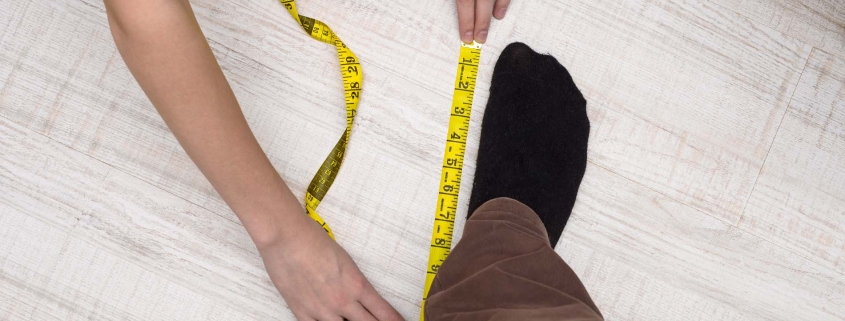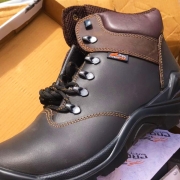SIZING: The Single Most Important Factor when Buying Safety Footwear
It’s probably been a very long time since you were a kid, experiencing the years pass you by between age 6 and 18. I recall vividly, the annual (or sometimes bi-annual) anguish my parents visually expressed when I advised them my school shoes no longer fitted my feet. That rapid growth from kiddies size 11 to adult size 5 over the space of just 4 or 5 years goes to shows the remarkable and ever changing foot growth we experience. It’s important to remember that whilst around age 18 things start to become more “stable” and growth does plateau… but, your feet never stop growing. Now when wearing a slipslop, sandal, running shoe, dress shoe or even slippers, all these upper materials can and will stretch and distort. They are flexible and designed to do so. Of course you need to be in the correct “ball-park” size, but even if you are out a little bit, you don’t experience serious discomfort or fatigue. The soles are soft and super flexible, made from super lightweight PVC or EVA. And for example, if you are a Size 8, that will be the first size you ask for when trying on a new pair in store. Often, you may even ask for a Size 7 and Size 9 to accompany the fitting session. You walk around a bit, maybe jump up and down once or twice and even do a little Usain Bolt sprint over a few metres. And once satisfied, you purchase.
In the industrial sector, we have a few things to take into consideration.
- You, or your company procurement manager may be making a bulk purchase of one style of shoe or boot for an entire workforce. This, simply issued to you based on previous purchase records from the years’ before, or on your stating your size at your new place of work.
- The upper materials on safety footwear are not fabrics or materials, but thick leather animal hides. They are able to be “broken-in”, and soften over a week or two with the application of polish (nourishment) and exposure to heat (like the sun) and your daily foot movement.
- We now have an immovable steel toe cap at the front. Which will cover your forefoot and toes. It does not bend, flex or stretch. It will not be broken!
These three factors are the founding principles of why accurate sizing is crucial to comfort, safety and productivity. And why it is so important to ensure you are getting into the correct size safety boot or shoe.
We always stress to our clients, that our footwear is graded and measured to be purchased in UK sizing. Often errors are made when someone buys in US sizing, which is a full size difference out. That will bring a whole world of hurt, confusion and irritation to the purchaser who will argue that the “boot is a problem”, where the entire exercise can simply be resolved with asking if they ordered based on UK or US sizing. And what about continental (EUR) sizing? Size 42 for example, is a UK Size 8.
So it becomes very important to make sure you check your conversion country, and sizing annually. Age, bodyweight and work environment all play a part in foot sizing changing over the years or even during the course of the day. The foot is about 7% larger in the afternoon than when you woke and stood up on the same morning. So we always recommend measuring your feet in the afternoon, as to ensure the boot or shoe will fit best at your largest size during the day. Every extra 5kgs of weight you add to your frame, also applies further pressure onto your feet and makes them larger. In the same way your pants size changes.
We get calls from clients asking us to please tell them what size they should buy, based on what shoe they normally wear daily (the DWK; dans / werk and kerk). The easiest way to check this measurement is often to stand barefoot, on a blank A4 sheet of paper… corner to corner, and measure from the furthest point of the outer edge of your foot, from the centre of your heel to your big toe. Based on that centimetre reading, you will fall into a sizing chart.
We’ve added this sizing chart for you to review before your purchase.
And one final thing, a nice comfortable, snug fit is exactly what you want. Don’t buy a size up because of the steel toe cap. Toe caps are designed with a bit of “let” in the front. Buy the UK size you normally wear. You don’t want a boot or shoe that is too big (or you will slide around inside), nor too small (as the tightness will end up causing pressure on the nerves around the feet, blisters on the toes, and a burning sensation underneath the feet).
So get it right the first time, be comfortable and stay productive. It is not always the boot’s fault 😊
| US Sizes | Euro Sizes | UK Sizes | Inches | CM |
| 6 | 39 | 5.5 | 9.25″ | 23.5 |
| 6.5 | 39 | 6 | 9.5″ | 24.1 |
| 7 | 40 | 6.5 | 9.625″ | 24.4 |
| 7.5 | 40-41 | 7 | 9.75″ | 24.8 |
| 8 | 41 | 7.5 | 9.9375″ | 25.4 |
| 8.5 | 41-42 | 8 | 10.125″ | 25.7 |
| 9 | 42 | 8.5 | 10.25″ | 26 |
| 9.5 | 42-43 | 9 | 10.4375″ | 26.7 |
| 10 | 43 | 9.5 | 10.5625″ | 27 |
| 10.5 | 43-44 | 10 | 10.75″ | 27.3 |
| 11 | 44 | 10.5 | 10.9375″ | 27.9 |
| 11.5 | 44-45 | 11 | 11.125″ | 28.3 |
| 12 | 45 | 11.5 | 11.25″ | 28.6 |
| 13 | 46 | 12.5 | 11.5625″ | 29.4 |
| 14 | 47 | 13.5 | 11.875″ | 30.2 |
| 15 | 48 | 14.5 | 12.1875″ | 31 |
| 16 | 49 | 15.5 | 12.5″ | 31.8 |







